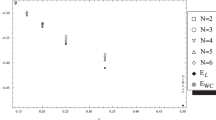Abstract
The dynamic structure factor S(q, ω) for a model of superfluid 4 He in disorder is evaluated using Path Integral Monte Carlo and Maximum Entropy methods. Disorder is represented by randomly distributed static impurities interacting with the 4 He atoms via a simple attractive potential. The potential is parametrized to yield different values of the variance and correlation length of the resulting disordering environment. New weight in S(q, ω) at low ω (i.e., low energy excitations) is induced by disorder, as predicted in some previous calculations, and S(q, ω) is broadened. Assuming that S(q, ω) in disorder is dominated by a single peak, just as in the pure superfluid, the data suggest that the peak position is shifted by the disorder from the bulk value with a unique q dependence. The static structure factor S(q) is reduced at all wave vectors with increased impurity concentration.
Similar content being viewed by others
REFERENCES
D. J. Thouless, Phys. Rep. 13C, 93 (1974).
M. P. A. Fisher, P. B. Weichman, G. Grinstein, and D. S. Fisher, Phys. Rev. B 40, 546 (1989).
M. Ma, P. Nisamaneephong, and L. Zhang, J. Low Temp. Phys. 93, 957 (1993).
M. H. W. Chan, K. I. Blum, S. Q. Murphy, G. K. S. Wong, and J. D. Reppy, Phys. Rev. Lett. 61, 1950 (1988).
M. Larson, N. Mulders, and G. Ahlers, Phys. Rev. Lett. 68, 3896 (1992).
J. D. Reppy, J. Low Temp. Phys. 87, 205 (1992).
A. I. Larkin, Zh. Eksp. Teor. Fiz. 58, 1466 (1970) [Sov. Phys. JETP 31, 784 (1970)].
D. R. Nelson and K. S. Seung, Phys. Rev. B 39, 9153 (1989).
D. A. Huse and K. S. Seung, Phys. Rev. B 42, 1059 (1990).
D. S. Fisher, M. P. A. Fisher, and D. A. Huse, Phys. Rev. B 43, 130 (1991).
G. Blatter, M. V. Feigel'man, V. B. Geshkenbein, A. I. Larkin, and V. M. Vinokur, Rev. Mod. Phys. 66, 1125 (1994).
M. G. Forrester et al., Phys. Rev. B 41, 8749 (1990).
M. C. Cha et al., Phys. Rev. B 44, 6883 (1991).
A. van Otterlo et al., Phys. Rev. B 48, 3316 (1993).
S. Bhattacharya and M. J. Higgins, Phys. Rev. Lett. 70, 2617 (1993); Phys. Rev. B 49, 10005 (1994).
L. Balents and M. P. A. Fisher, Phys. Rev. Lett. 75, 4270 (1995).
M. C. Cha and H. A. Fertig, Phys. Rev. B 50, 14368 (1994).
R. Seshadri and R. M. Westervelt, Phys. Rev. B 46, 5142 (1992); 46, 5150 (1992).
A. A. Middleton and D. S. Fisher, Phys. Rev. B 47, 3593 (1993).
D. K. K. Lee and J. M. F. Gunn, J. Low Temp. Phys. 89, 101 (1992) and references therein.
L. Zhang, Phys. Rev. B 47, 14364 (1993).
W. Krauth, N. Trivedi, and D. M. Ceperley, Phys. Rev. Lett. 67, 2307 (1991).
M. Makivic, N. Trivedi, and S. Ullah, Phys. Rev. Lett. 71, 2307 (1993).
M. Boninsegni and D. M. Ceperley, J. Low Temp. Phys. 104, 336 (1996).
J. de Kinder, G. Coddens, and R. Millet, Z. Phys. B Cond. Mat. 95, 511 (1994); G. Coddens, J. de Kinder, and R. Millet, J. Non-Cryst. Sol. 188, 41 (1995).
P. E. Sokol, M. R. Gibbs, and M. A. Adams, Nature 379, 616 (1996); M. R. Gibbs, P. E. Sokol, W. G. Stirling, R. T. Azuah, and M. A. Adams, J. Low Temp. Phys. 107, 33 (1997); R. M. Dimeo, P. E. Sokol, D. W. Brown, C. R. Anderson, W. G. Stirling, M. A. Adams, S. H. Lee, C. Rutiser, and S. Komarneni, Phys. Rev. Lett. 79, 5274 (1997).
O. Plantevin et al. (1997), unpublished.
R. A. Aziz, M. J. Slaman, A. Koide, A. R. Allnatt, and W. J. Meath, Mol. Phys. 77, 321 (1992).
D. M. Ceperley, Rev. Mod. Phys. 67, 279 (1995).
See, for instance, I. M. Lifshits, S. A. Gredeskul, and L. A. Pasteur, Introduction to the Theory of Disordered Systems, John Wiley & Sons, New York (1988).
Because of the use of periodic boundary conditions, C(r) features a spatial periodicity L equal to the size of the replicated simulation cell. In this study, therefore, we restricted ourselves to values of the correlation length of the disordering potential less than L/2.
M. Jarrell and J. E. Gubernatis, Phys. Rep. 269, 133 (1996).
H. N. Robkoff and R. B. Hallock, Phys. Rev. B 25, 1572 (1982).
E. C. Svensson, V. F. Sears, A. D. B. Woods, and P. Martel, Phys. Rev. B 21 3638 (1989).
H. R. Glyde, Excitations in Liquid and Solid Helium, Oxford University Press, Oxford (1994).
R. J. Donnelly, J. A. Donnelly, and R. N. Hills, J. Low Temp. Phys. 44, 471 (1981).
Author information
Authors and Affiliations
Rights and permissions
About this article
Cite this article
Boninsegni, M., Glyde, H.R. Excitations of Liquid 4He in Disorder. Journal of Low Temperature Physics 112, 251–264 (1998). https://doi.org/10.1023/A:1022641900623
Issue Date:
DOI: https://doi.org/10.1023/A:1022641900623




